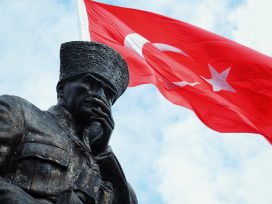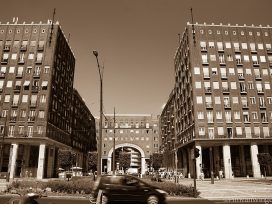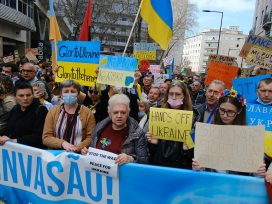Shortly after the breakthrough of 1989 and the fall of communism, Grzegorz Ekiert and Jan Kubik, two researchers studying civil society in post-communist countries, noted the emergence in central and eastern Europe of “rebellious civil societies”. For these societies, public protest was perhaps the most important form of civil political activity. The elites of these countries feared street demonstrations, viewing them as a threat to reform, and the protesters were dubbed – particularly after Józef Tischner introduced Aleksandr Zinovyev’s term into the Polish language – Homo Sovieticus. However, rather than being a threat to reform, participation in protests was at the time an important factor in consolidating democracy.
This was so due to the fact that, as citizens, we had roughly two ways of influencing those in power: conventional ones that involved institutions, and non-institutional ones. The first way included participation in elections and referendums or activity in political parties or social organizations. The second meant responding to unsatisfactory government policies by participating in protests and social movements.
Right after communism, during the first decade of the Third Republic of Poland, Polish society was eager to protest and marching in the streets was the most natural form of civic engagement. But later these attitudes waned. Thereafter, social engagement remained relatively low, except of course for pockets of resistance that formed, for example, among the increasingly professionalized NGO sector. However, in general, Poles withdrew from the streets and grassroots social movements declined.
Today, we may venture the thesis that in the last few years we have witnessed the reappearance of “protesting civil society”. In Poland, we saw discrete movements against lowering the school age and against ACTA; there were conservative mobilizations after the presidential plane disaster in Smolensk, feminist mobilizations surrounding both pro-life and pro-choice demonstrations, the nationalist march of 11 November and the Equality Parade, as well as a certain renaissance of urban movements – all these protests (very diverse and frequently advocating opposing stances) are testimony to the existence of more or less grassroots movements, which can be interpreted as proof of changes in politics and the relationship between society and the government.
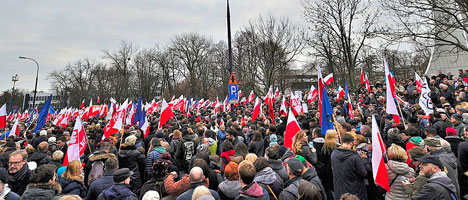
The Committee for the Defence of Democracy (KOD) demonstrate in front of the Sejm in Warsaw, 19 December 2015. Photo: Adrian Grycuk. Source:Wikimedia
However, it is also worth considering another aspect of the relationship between society and government expressed on the streets. Participation in demonstrations is after all not only a form of communication between society and government, or one possible response among others to government policies, but also a way for the government to communicate with its (potential or already convinced) voters. Today political parties, including those in power, are increasingly eager to utilize the forms of the activities that social movements practice, not least in order to capitalize on the inferred legacy of the eighties.
Events in Poland
Tens of thousands of nationalist demonstrators marched though Warsaw on Saturday, 11 November 2017, in what observers say was one of the biggest gathering of far-right activists in Europe in recent years.
Why Poland? And why now?
Eurozine presents the following texts from recent years that explore the political and social context in Poland.
The legacy of communism is not an adequate explanation to the rise of the right there, says Pawel Marczewski.
Across Europe, and especially in Hungary and Poland, parliamentary politics has become increasingly intertwined with the politics of street protest, writes Mateusz Falkowski.
Meanwhile, one of Poland’s leading writers and critics, Andrzej Stasiuk, explores what drove him to realize a lifelong dream, and strike out ever further eastwards, away from his childhood home.
Trade unions (which in the past were the most important organizers of demonstrations) no longer dominate the landscape of Polish protest politics, and the transformation of society and wage demands for which they used to campaign have ceased to be the main points of reference. In recent years, marches have become institutionalized – popular, repeatable and considered as a normal, acceptable form of political expression – to the extent that a growing number of political and ideological circles and groups try to channel the anger and support of their partisans into this particular form of activity.
Parties and protest movements
Rallies in various Polish cities after the autumn parliamentary elections attest to an increase in the political temperature and a change in parties’ mobilization strategies. On one December weekend in Warsaw in 2015, we even witnessed a sort of competition between the demonstrations of critics and of supporters of the new government. This should not be surprising. In central Europe for some time now, different types of extra-institutional forms of political action have been gaining importance. People express their anger in the elections, voting for “protest parties”, but they also do so in the streets by demonstrating under the slogans of Pegida in Dresden, in the March of Independence in Warsaw or “for bread” in the Bosnian city of Tuzla. Parliamentary politics has become more strongly intertwined with the politics of street protest.
In Poland the populist rock singer Pawel Kukiz, soon after scoring a very good result in the presidential elections in May 2015, introduced over 40 MPs into the Polish Sejm. His alliance with the nationalists is easier to understand when we note that five years ago the singer was a committee member in the increasingly popular March of Independence, which is organized by nationalists and gathers tens of thousands of participants every year. Another politician of the new kind, this time associated with banks and the political establishment, Ryszard Petru, also builds support for his party Nowoczesna by encouraging street protests.
Even more interestingly, mobilizing supporters through street protests is not a strategy that is confined to opposition parties. The same strategy was pursued by Fidesz in Hungary, and by the ruling Prawo i Sprawiedliwosc (Law and Justice) in Poland. On both sides of the political spectrum we see attempts at mobilization in the form of marches and demonstrations, as well as politicians attempting to use these protests for their own ends. After the period of transformation from communism to market economies and democracy, and after the accession of central and eastern European states to the European Union, we are seeing a new dynamic emerge across social and political spheres.
An ostensibly extra-institutional politics of protest appears to complement the procedures of traditional political institutions. Sometimes elections themselves start to visually resemble street demonstrations. In November 2014, during the Romanian presidential election, crowds stood for many hours, queuing before Romanian embassies in western capitals in order to cast votes of protest against president Victor Ponta. On the same day, the Czechs protested in the streets, holding red cards in protest against the politics of Milos Zeman. There came a point when it was hard to tell which press photographs portrayed the election and which portrayed the demonstrations.
Meanwhile the elites often openly attacked street politics. In November 2010 professor Marcin Król, a philosopher of politics from the University of Warsaw, one of the most active commentators on Polish political life, went as far as to suggest hauling politicians before the State Tribunal for organizing street demonstrations. “In parliament, MPs have the right to say what they want. But now Jaroslaw Kaczynski has taken the political dispute into the street. This is an utter transgression of the rules of democracy. Parliament was invented so that disputes would be held in parliament, not in the street”, commented Król.
Opposition in parliament and in the streets
Poles however did not want to limit disputes only to the Sejm and instead started to participate in street politics. In autumn 2010, the March of Independence organized by the nationalists attracted more than a close circle of activists: it managed to gather around 10,000 participants, a number that has since grown by thousands more in subsequent years as people from outside the nationalist-right organizations joined the march too. The nationalists thus made an attempt to institutionalize their ideological movement not through a classical political party, nor through their Mlodziez Wszechpolska (All-Polish Youth) organization, but through shifting the weight to the Association of the March of Independence, established specially for this purpose, and the annual 11/11 demonstration.
Marches also became an important mobilizing tool for the parliamentary opposition. Monthly rallies commemorating the Smolensk disaster attracted many people. In 2011 the main opposition party, seeing the mobilizing effect of these actions, came up with the idea of another march. In a move undoubtedly intended to rival the efforts of nationalist circles that had dominated the 11 November proceedings, the PiS organized the March of Independence and Solidarity on the anniversary of the introduction of martial law. The march went ahead on 13 December 2011 under the slogan “There cannot be a just Europe without an independent Poland”.
At the same time, PiS started building a network of civil society organizations around the party, among which the most important role was played by the clubs run by Gazeta Polska and the catholic broadcaster Radio Maryja, both of which sympathized with the party. These conservative civil society organizations close to the political Right enabled the party to survive some difficult moments and mobilize supporters.
From that moment on, marches evoking the memory of martial law victims, and referencing the tradition of the anticommunist demonstrations of the 1980s, became an important identity-building element for PiS. In one of his speeches at the March of Independence and Solidarity, Jaroslaw Kaczynski reminded his audience of “the basic values of our community – liberty, solidarity and independence”; the crowds before him responded by chanting “Ja-ros-law, Ja-ros-law!” The march grew and it became larger than just one group. A year later the appeal of marching in the cold through the snow was discovered by those campaigning on particular issues: opponents of proposals to build a nuclear power plant in Gaski, for example, and the anti-GMO movement.
In 2014, a march “in defence of democracy and media freedom” was called following irregularities in local government elections, the results of which were seen as rigged. Jaroslaw Kaczynski criticized the then-ruling Platforma Obywatelska (Civic Platform), claiming that “the government and the president are terrorizing the courts”. Paradoxically, PiS’s slogans from December 2014 were repeated in almost exactly the same place and exactly the same form by its opponents a year later.
After the 2015 presidential and parliamentary elections and PiS’s rise to power, the annual march that was so important for the party while in opposition might have been expected to lose its significance. But on Sunday 13 December 2015, the fifth March of Liberty and Solidarity took place almost spontaneously. Despite the rain and cold, tens of thousands of people demonstrated their support for the government and the president. The decisive factor that led to the march going ahead was the demonstration for the defence of democracy and rule of law held the previous day by Komitet Obrony Demokracji (the Committee for the Defence of Democracy) and opposition parties. The crowd that had protested against the government chanted “This is Warsaw, not Budapest”, indicating they did not want PiS to follow in the steps of Viktor Orbán.
Leaving aside the differences between Hungary and Poland, which are many, the mobilizing strategies of PiS and Fidesz are intriguingly similar. Almost parallel to the rallies organized by PiS from 2012 to 2014, Fidesz (at that time already in power) organized six “Peace Marches for Hungary” (Bekemenet) in order to mobilize its supporters and legitimize Orbán’s politics.
Hungarian divides
Hungary is experiencing divides that are probably even deeper than those in Poland. The left-wing sociologist Pal Tamas tells me that in Budapest the two social camps read different newspapers and use completely different arguments that are oblivious to the perspective of the opposing side. To a certain extent this resembles the situation in Poland when the conservative Gazeta Polska, which sympathizes with PiS, encourages its readers to participate in one march while the left-wing/liberal Gazeta Wyborcza, which is closer to PO, advertises the other march – and the readers of the two publications do not find any common ground for dialogue. These divides often cut across families, friendships and professional circles. In Poland they became stronger after the presidential plane disaster in Smolensk, in Hungary this occurred during prime minister Viktor Orbán’s second term.
Fidesz, which now rules Hungary, started as an illegal protest movement in the era of
János Kádár and has preserved this “underground” aspect of its identity. Even as a ruling party it was eager to appeal to its old dissident movement identity, shifting it towards mobilizing populism.
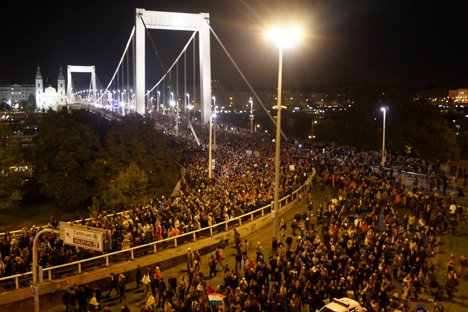
Protest in Budapest against the Orbán government and its proposed Internet tax, October 2014. Photo: Adrian Grycuk. Source:Flickr
When confronted with criticism of the changes in the constitution and media law voiced by the West and the liberal Left, Fidesz decided to win additional legitimacy for its actions. On the evening of 21 January 2012, 100,000 people showed their support for Orbán by marching on one of Budapest’s main boulevards. At the front of the march, conservative journalists carried a banner saying “We won’t be a colony”. The calm crowd waved Hungarian flags and signs that equated the EU with the USSR, sang patriotic songs and chanted “Viktor, Viktor”.
Subsequent marches were organized every few months, partly in reaction to the founding of the left-wing-liberal opposition platform Milla. The opposition only started organizing its first larger protests about a year after Orbán’s second government came to power – a response time far in excess of that between PiS coming to power and subsequent opposition protests in Poland. Hungary’s “One Million for Press Freedom” movement, Milla, began with grassroots protests in defence of freedom of expression on 15 March 2011. Slowly, from an initiative centred around a single theme, it was transformed into a more institutionalized opposition platform, filling the void caused by the great weakness of the Left after eight years in government.
Viktor Orbán dealt with these challenges quite effectively, and the government did not limit its actions to parliament. While the Left was still in power, Fidesz had gone back to its roots and, in 2002, began building a social movement (polgári körök). Over 10,000 local cells were set up, political debates were organized and the opposition’s morale revitalized.
Mihály Gyimesi, a political scientist researching social movements in Hungary, claims this hybrid strategy of combining a political party with a social movement intensified under Orbán, once he gained power again in 2010. Pro-government marches started to be organized not directly by the party but by quasi-governmental NGOs close to those in power, like Civil Összefogás Fórum. These marches took place on the dates of important historical events: 15 March, the anniversary of the beginning of the 1848 revolution, and 23 November, the anniversary of the 1956 revolution. Like in Poland, supporters were mobilized around values represented by the heroes of those historical events.
Fidesz, PiS and social movement strategies
Politicians in Poland looked to the example of Hungary not only in relation to concrete public policy (like the bank tax), but also to political strategy. In both countries, sections of the deeply divided societies can be mobilized as conflicts arise. Both Fidesz and PiS draw on the legacy of the eighties, referencing the anti-communist social movements. They mould this legacy according to their own needs, such that both parties become increasingly similar to social movements, especially as regards their methods of mobilization.
The parties rely not only on MPs, but also on activists and organizers who are not formal party members. In Hungary, conservative journalists played an important role for Fidesz. In Poland, the ruling PiS also has similarly unaffiliated support at its disposal, including the organizers from Klub Ronina (a right-wing political discussion club in Warsaw) and Ruch Kontroli Wyborów (a social movement that functions as an electoral watchdog). During a meeting with Gazeta Polska clubs in May 2015, the head of the party, Jaroslaw Kaczynski, spoke directly of the social movement strategy: “without social support expressed also in the streets we won’t make it.”
Both conservative parties, Fidesz in Hungary and PiS in Poland, used similar means to retain their supporters during long spells in opposition. In Hungary these were polgári körök, in Poland organizations like the Gazeta Polska clubs. Just as Fidesz organizes marches in response to the protests of the liberal-leftist coalition Milla, PiS organizes them in reaction to the actions of the Committee for the Defence of Democracy. Left-wing liberal parties are learning to adopt and adapt the strategies of these conservative parties. In Poland Platforma Obywatelska has just formed a network of “civic clubs” as a liberal counterpart to organizations in the conservative movement directly linked to political parties.
In both countries the conservatives currently have the edge in terms of mobilizing support in this way, partly because it was the conservative parties that reached for the arsenal of social movements when in opposition. Finally, both in Poland and in Hungary we are witnessing the clash of two ways of interpreting democracy – a more populist and a more liberal vision. The conflict arising from these two interpretations is what now drives the current dynamics of protest.
Plus Minus
